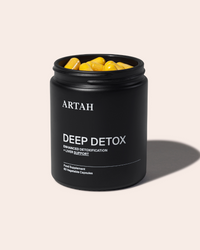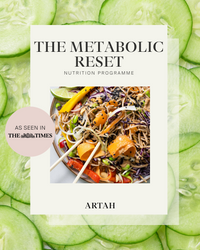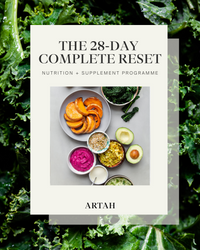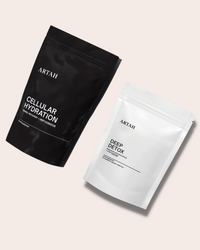These Metabolism Boosting Recipes Will Change Your Life
Healthy eating often gets a bad wrap, but good news: it doesn't need to be steamed chicken and broccoli lined up in Tupperwares for the week. We can still eat in a way that fuels our metabolism, nourishes the microbiome, and balances blood sugar, without compromising on taste. That's why we love these recipes - they're seriously delicious, easy to make, and packed with metabolism boosting vitamins, minerals, and phytonutrients.
Nasi Kuning
Nasi Kuning is Indonesian turmeric rice, and we created a lower carb version for our Metabolic Reset programme that is still incredibly satisfying but packed with phytonutrients. Cauliflower is rich in sulforaphane, which supports gut health, immunity, and detoxification, whilst turmeric keeps inflammation at bay. You can serve this as a plant-based main, or add a fried egg to make it a little more substantial.
Ingredients
- 250-300g cauli-rice (about 1 cauliflower, 'riced')
- 1/2 can of full fat coconut milk
- ½ tsp turmeric
- ½ tsp salt
- 2 lime leaves (optional)
- 2 handfuls kale or spring greens shredded
- Juice of ½ a lime
- 2 handfuls baby tomatoes, roughly chopped
- 2 spring onions, roughly chopped
- 1 avocado, roughly chopped
- 2 tbsp chilli oil (optional)
- Small handful coriander, roughly chopped
- Optional: Add a fried egg to up the protein
Method
- Using a food processor, chop the cauliflower into rice using the pulse function. If you don't have one, you can use a box cheese grater or chop into rice like pieces by hand.
- In a medium saucepan or non-stick frying pan, add the rice, coconut milk, turmeric, salt and lime leaves. Cook for 5 minutes until piping hot.
- Stir in the kale and lime juice.
- Once ready, top with the chopped baby tomatoes, spring onions, coriander, and avocado, and then top with chilli oil to serve.
- Top with a fried egg for a non-vegan option.

Seared Sirloin with Kimchi Mayo + Cauli Rice
Serving lighter, plant-based sides with lots vegetables and lots of herbs alongside meat, rather than more traditional options (think fries or roasted potatoes) is the way to go if you're craving balance, which is why we love this recipe. Meat quality is important; organic, grass fed beef has a higher omega 3 fat content and lower inflammatory fat content, so we always recommend seeking out good quality beef from local markets (it's less expensive too). Good quality red meat is also packed with nutrients like Iron, Carnitine and Creatine, whilst cauliflower does wonders by enhancing our natural detoxification pathways.
Ingredients
- 1 block silken tofu
- 1 tsp Dijon mustard
- 1 tsp apple cider vinegar
- 1 tsp salt
- 2 tbsp kimchi and its juice
- Large handful of mixed herbs, roughly chopped (we love parsley, coriander, basil)
- 4 tbsp capers and juices
- 2 tbsp gherkins and juices (optional)
- 1 clove of garlic
- 2 spring onions, roughly chopped
- 1 tsp salt
- 2 tsp pepper
- 250g cauli rice (about 1 cauliflower)
- 1 sirloin steak per person + coconut oil to cook
Method
- To make the kimchi mayo, place the tofu, mustard, apple cider vinegar, salt, kimchi and kimchi juices in a high-speed blender or NutriBullet and blitz until smooth and creamy. Add more kimchi for a stronger flavour if you would like.
- Place the herbs, capers, gherkins, garlic, spring onions, ½ tsp salt and 1 tsp pepper in a high-speed blender or NutriBullet and pulse a couple of times to create a rough paste. Prepare the cauliflower as above and lightly fry with some olive oil or coconut oil until al dente and warm, about 5 minutes. Mix everything together
- Season both sides of the steaks with salt and pepper.
- Heat the oil in a medium saucepan on high heat. Once hot add the steaks and fry for 2-3 minutes on each side depending on their size for medium rare. Remove from the heat and allow to rest for 5 minutes.
- Once ready to serve, slice the steaks into thin slices and serve alongside the cauli rice with a dollop of kimchi plant mayo.

Butternut Squash Spaghetti with Creamy Cashew Sauce and Walnut Parmesan
There are few things better than a big bowl of warm pasta, but it can also be a little too starchy. Spiralized vegetables are a brilliant way to improve the nutrition content of your pasta dish, and using squash ensures you still get a carby feel (as opposed to something like courgette). You could also mix it up, using part squash, part pasta, or whatever vegetable you're inspired to use. You can also serve as a side to some grilled chicken or fish for an omnivore option. If you haven’t managed to soak the cashews overnight then soak them in boiled water for 30 minutes.
Ingredients
- 70g (1/2 cup) cashews, soaked overnight
- 40g (1/4 cup) sunflower seeds, soaked overnight
- 3-4 tbsp of the solid part of a can of full fat coconut milk, alternatively, you could use an unsweetened plant cream like oat cream or soya cream
- 2 tbsp nutritional yeast
- 1/2 a courgette (roughly 100g), peeled
- 1/2 tsp salt
- Juice of 1/2 lemon
- 450-500g butternut squash, peeled and spiralized
- 2 handfuls spinach, washed and ready to eat
To serve
- 2 walnuts, finely grated using a micro-plain or parmesan grater
- 1 tbsp pumpkin seeds, chopped
- 1 tsp pumpkin oil, (optional; could also use EVOO)
- 8 basil leaves
- Cracked black pepper
Method
- In a high-speed blender or Nutri-Bullet, combine the drained cashew nuts, seeds, milk/cream, nutritional yeast, courgette, salt and lemon and blitz to a smooth creamy sauce. Set aside.
- Bring a pan of seasoned water to the boil and add the butternut squash. Cook for 1 minute, just to remove the ‘rawness’ from the vegetable which will make it easier to digest. At the last minute add the spinach and then drain the water reserving a centimetre in the pan. Add the cashew cream and stir to combine. Place back on the heat to warm the sauce.
- Serve immediately with some of the walnuts, seeds and a good drizzle of pumpkin or olive oil. Finish with some fresh basil and a good seasoning of cracked black pepper.
To get inspired with more recipes, check out our nutrition programmes.









































